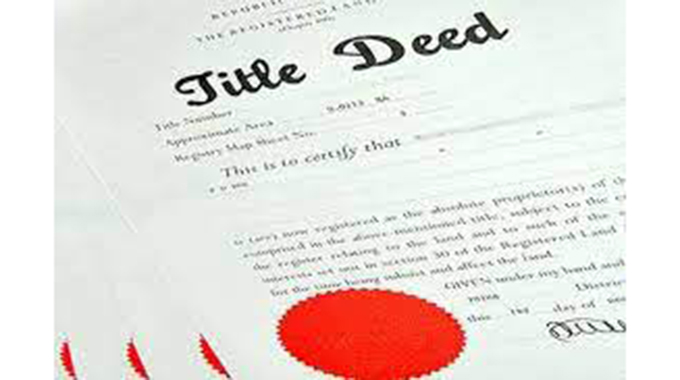Process of acquiring a property, title deeds

Godknows Hofisi
Many people and organisations are interested in acquiring properties in the form of vacant pieces of land and build or properties that are already built. This could be to use for residential purposes, for business premises or as investments.
This article briefly explains the process involved from purchasing an immovable property up to obtaining deed of transfer which is commonly referred to as title deed.
Purchase of a property
A seller of a property, for example a house, usually approaches a registered estate agent to sell on his / her behalf. An estate agent knows the market conditions, price range and other factors relevant to the sale. The seller gives the agent the mandate to sell, whether sole mandate or not.
Once given the mandate the estate agent markets the property in order to find a buyer. A buyer is normally required to make a formal offer. If the offer is accepted by the seller then the seller and prospective buyer enter into an agreement of sale for the property.
For the agreement of sale it is advisable to use a registered legal practitioner who is a conveyancer and involve the estate agent. Upon successful conclusion of the agreement of sale and payment of the purchase price by the purchaser the estate agent becomes entitled to an agency commission which is regulated.
Ideally the funds making up the purchase price or consideration should be transferred into a trust bank account of the law firm which will do the conveyancing. The funds should be held in trust and only released upon successful registration of the property. This is meant to protect the purchaser and the seller. It may happen that the seller and the buyer may agree on other payment arrangements.
Conveyancing or transfer
The appointed conveyancer then handles the conveyancing, basically to effect transfer of title from the seller to the buyer. Most buyer are very keen to know how quickly that can be done. Hopefully this article will give some shed some light.
Conveyancing fees
The buyer is required to pay conveyancing fees to the conveyancer. The fees are regulated by the Law Society of Zimbabwe.
Capital Gains Tax certificate by ZIMRA
The conveyancer facilitates the process whereby ZIMRA will assess whether the seller is liable to pay Capital Gains Tax (“CGT”) on the sale in order for the CGT clearance to be issued by ZIMRA. Ordinarily, subject to certain considerations at law, a seller is liable to pay CGT where the selling price is higher than allowable costs. In other words the seller would have realised a capital gain on the sale of the property. When ZIMRA has issued an assessment the seller is required to pay the CGT. Usually this is paid from the transaction proceeds after which ZIMRA issues a CGT clearance. It may happen that there may be no CGT payable.
Lodging at the Deeds Office
Properties are registered for deeds of transfer at the Deeds Office in terms of the Deeds Registries Act (Chapter 20:05) and accompanying regulations. It is the conveyancer who handles the conveyancing to give effect to the transfer from the seller to the buyer.
The following documents are lodged by the conveyancer:
New or draft deed of transfer which would have been drafted by the conveyancer, bearing the name of the buyer as the new owner. This drafting requires specialist skills and knowledge,
Current original deed of transfer in the name of the seller,
CGT certificate issued by ZIMRA,
Rates clearance, issued by the local authority. There is need to clear any amounts due to ZESA,
Power of Attorney to pass transfer,
Consent by the local authority in case there are restrictions to transfer,
Stamp duty which is paid to Government,
Declarations by seller and purchaser,
Relevant diagrams from the Surveyor General, if needed.
The documents to be lodged together with the new or draft deed of transfer will vary depending on the cause of the transfer, known as “causa” for example sale or transfer from a deceased estate.
In the case of land development documents such as compliance certificate issued by the local authority is usually required.
Deeds Office
The Deeds Office has examiners who are trained to scrutinise lodged documents for compliance, correctness, completeness and other considerations. If the Deeds Office is satisfied with the lodged documents the lodged deed drafted by the conveyancer is then allocated a number, registered and signed by the Registrar of Deeds. One original deed is retained by the Deeds Office whilst the other is given to the conveyancer who then passes it on to the buyer.
Time taken
The time taken will vary with the complexity of the transfer and the time taken by the different processes.
Disclaimer
This simplified article is for general information purposes only and does not constitute the writer’s professional advice.
Godknows Hofisi, LLB(UNISA), B.Acc(UZ), CA(Z), MBA(EBS,UK) is a legal practitioner / conveyancer with a local law firm, chartered accountant, insolvency practitioner, consultant in deal structuring and tax and is an experienced director including as Chairperson. He writes in his personal capacity. He capacity. He can be contacted on +263 772 246 900 or [email protected].










Comments